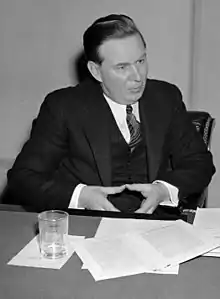Thomas Ryum Amlie
Thomas Ryum Amlie (April 17, 1897 – August 22, 1973) was a U.S. representative from Wisconsin, elected to Congress as a member of the Republican Party from 1931 to 1933 and again from 1935 to 1939 as a member of the Wisconsin Progressive Party.
Thomas Ryum Amlie | |
|---|---|
 | |
| Member of the U.S. House of Representatives from Wisconsin's 1st district | |
| In office January 3, 1935 – January 3, 1939 | |
| Preceded by | George Washington Blanchard |
| Succeeded by | Stephen Bolles |
| In office October 13, 1931 – March 3, 1933 | |
| Preceded by | Henry A. Cooper |
| Succeeded by | George Washington Blanchard |
| Personal details | |
| Born | April 17, 1897 Binford, North Dakota, US |
| Died | August 22, 1973 (aged 76) Madison, Wisconsin, US |
| Political party | Republican Wisconsin Progressive Party |
Biography
Born on a farm near Binford, North Dakota, Amlie went to the Cooperstown, North Dakota high school and then to the University of North Dakota and University of Minnesota. Amlie received his law degree from University of Wisconsin Law School and practiced law first in Beloit, Wisconsin and then in Elkhorn, Wisconsin.[1]
In October 1931, Amlie was elected as a Republican to represent Wisconsin's 1st congressional district in the 72nd United States Congress, replacing Henry A. Cooper who had died in office, and served until March 1933. He then switched to the Wisconsin Progressive Party, an alliance established in 1934 between the longstanding "Progressive" faction of the Republican Party of Wisconsin, led by the La Follette family and their political allies, and certain radical farm and labor groups active in Wisconsin at the time [2] He was reelected on the party ticket to the 74th and 75th United States Congresses and served from January 3, 1935, till January 3, 1939.
From 1936, Amlie and the WPP were informally allied with the New Deal coalition and supported the reelection of President Franklin Roosevelt.[3] After Amlie left Congress in 1939, the President nominated him to the Interstate Commerce Commission, but Amlie asked that the nomination be withdrawn.[4]
In 1938, Amelie served on a committee for the defense of Fred Beal. Returned from the Soviet Union, Beal was facing recommittal in North Carolina where in 1929 as a union organiser he had been convicted in a conspiracy trial. He had been deserted by the Communist-controlled International Labour Defense because of the witness he was now bearing to the realities of Soviet collectivization. Serving with Amlie on the committee were Homer Martin of the UAW,[5] Democrat Jerry Voorhis; the sociologist and pacifist Emily Greene Balch, the New York attorney and feminist Dorothy Kenyon and the poet Sara Bard Field.[6] The Committee reported hostile pressure from members of the ILD and anonymous threats.[7]
Returning from Washington DC, Amlie resumed the practice of law in Madison, Wisconsin, where he resided until his death August 22, 1973.[8] Through his brother Hans, he was the brother-in-law of Milly Bennett.[9]
Notes
- 'Wisconsin Blue Book 1937, Biographical Sketch of Thomas Ryum Amlie, pg. 19
- Wisconsin Progressive Party The Historical Marker Database
- William E. Leuchtenburg, Franklin D. Roosevelt and the New Deal, 1932-1940 (1963) p. 190.
- "Withdrawal of the Nomination of Thomas R. Amlie for the Interstate Commerce Commission. | The American Presidency Project". www.presidency.ucsb.edu. Retrieved 2022-11-18.
- Benedict, Daniel (1992). "Good-Bye to Homer Martin". Labour / Le Travail. 29: (117–155) 117. doi:10.2307/25143571. ISSN 0700-3862. JSTOR 25143571.
- "Martin, Kenyon, Hays Join Beal Defense Group". Socialist Appeal. 2 April 1938. p. 2.
- "Workers Must Rally Around Beal To Fight Sabotage of His Defense" (PDF). Socialist Appeal. February 19: 3. 1938.
- "AMLIE, Thomas Ryum | US House of Representatives: History, Art & Archives". history.house.gov. Retrieved 2022-11-18.
- Kirschenbaum, Lisa A. (July 28, 2015). International Communism and the Spanish Civil War. Cambridge University Press. p. 179. ISBN 978-1-107-10627-7. Retrieved January 16, 2020.
External links
- United States Congress. "Thomas Ryum Amlie (id: A000176)". Biographical Directory of the United States Congress.